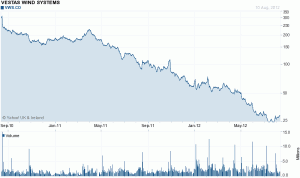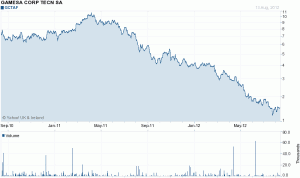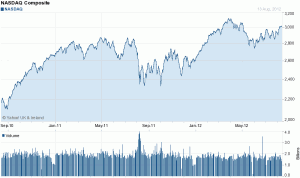Wind Power: Eco-Fad or Economic Fad?
Campaigning in Iowa, the President today defended wind energy subsidies, saying “These jobs aren’t a fad.” He was campaigning for the renewal of subsidies for wind energy and solar, known as the Production Tax Credit (PTC), claiming it creates jobs and clean energy. The Energy Information Administration notes that wind receives a subsidy of about 5 cents per kWh, compared to 6/100ths of a cent per kWh for natural gas or coal.
I pointed out in my book Eco-Fads that wind power is a fairly expensive way to reduce carbon emissions, costing about seven times as much to reduce a ton of carbon emissions as was paid in Europe under their cap-and-trade system.
Perhaps, as the President claims, promoting the creation of wind and solar energy is a good economic strategy, creating jobs and helping the economy recover. For one indication, we can look at the stock prices of renewable energy companies over the last two years since the PTC was renewed in the “stimulus” package.
Vestas is the largest wind turbine manufacturer in the world. It lost 90 percent of its value, falling from about 300 to 29 today.
Gamesa is another large wind turbine manufacturer. It is headquartered in Spain which has many wind turbines. Spain’s unemployment rate, by the way, is 24.8%. Gamesa’s stock price started at 8, rose to 11 and is trading at about 1.50 today, losing more than 80 percent of its value.
There are other wind companies, but most of them have other products (like GE) or are Chinese owned and heavily subsidized by that government. Analyzing their stock prices isn’t appropriate.
Solar manufacturers also benefit from these subsidies as well. How are they doing?
Suntech is one of the top solar manufacturers. Its stock began at about 9 and has fallen to 1, a loss of nearly 90 percent of its value.
First Solar is another one of the top producers. There was a bit of fanfare recently when its stock price rebounded a bit. Over the last two years, however, the stock price has fallen from about 120 to about 20 today — even with the recent bump, a loss of nearly 85 percent.
Finally, in 2009, SunPower bragged that it was the “blue chip” of solar energy companies. Since that time, the price rose from 12 to 22, then collapsed down to about 4, a loss of more than 80 percent since the peak a year ago.
The record is pretty consistent — losses of 80 to 90 percent for both wind and solar, at a time when the federal government was providing significant subsidies.
It is true that the country is in a recession, so part of the decline is related to the recession. Just to be fair, here is the graph of the NASDAQ during the same period for comparison purposes – a gain of more than a third from 2,200 to over 3,000.






Wind and solar energy can only place units within certain geographic locations. The cost of wind mill and solar panels replacement could outweight the increase projection of jobs and economic growth within certain areas of the United States. For example, the placement of wind mills in an area that has a high risk of migratory birds. Could end up costing more an increase in relocation to save endangered species or non endangered species.
When and solar are not dispatchable. This means every unit of alternative energy must be tended by an equal unit of dispatchable energy (generally natural gas)in order to keep supply and demand in balance to avoid collapse of the grid. This means alternative energy sources DO NOT add to capacity value, they only serve to reduce available reserves. On peak demand days this dirty little secret is revealed. As the penetration of alternative energy increases the folly of spending money on non-dispatachble resources will become apparent. Until a cost-effective storage system is developed alternative energy is a waste of money.
John is 100% correct and as a cost effective storage system is not even on the horizon wind and solar power are nothing but “feel good” politics for politicians who fail to exhibit due diligence and
a naive and gullible general public
The three previous comments are spot on. On the positive side, wind and solar energy have a place in the overall energy mix, particularly in remote locations such as farms, ranchs, deserts, and mountains where there is no electric grid available. This reality has evolved as it should in a free market environment where the best fit solution is applied as needed.
However, it is folly to try to replace or substantially augment the USA electric power grid with these sources which are best used for pumping water for livestock or operating night lights or farm gates. To do so is much like trying to use the rubber band that turns the propellor of a toy plane to provide power for an automobile; pure folly and not financially sustainable.
There is a chance that wind power may take off and becoming popular in rural, suburban, and/or exurban areas in the future.
As blacks become more frequent and the grid becomes strained and as prices continue to go up, wind power will become more popular.
If the fad continues, I forsee issues related to zoning and ordinances affecting where people can put up wind turbines.
Every form of energy we have can eventually be traced back to the Sun. Space based solar power solves the on/off problem of terrestrial solar power, and could be delivered nearly anywhere on the planet 24/7/365. These characteristics make space based solar power a virtually unlimited, clean baseload power source.
Currently, payload launch-to-orbit costs are the single biggest hurdle to developing and deploying space based solar power. While it would be a massive and complex engineering project, no basic science breakthroughs are needed before space based solar power could be implemented.
Space based solar power is not a short-term solution to our energy needs. Domestic fossil fuel resources would provide a “bridge” to its eventual implementation … but fossil fuel will be a “bridge to nowhere”, unless we start developing space based solar power very soon.
Rob Mahan
Citizens for Space Based Solar Power*
*I’m a purely self-appointed advocate, and I have no financial stake in space based solar power. I simply believe that it will eventually be the solution to our energy future.
Rob, that’s a very interesting point you make, I will definitely have to read more about it.
Everything else discussed previously is very spot on. I had the opportunity to take a class regarding the social impacts of wind energy during my senior year and learned a great deal regarding the matter. While there are problems, especially with the lack of cost-effective storage, these problems may be overcome in the future with advances in super-conductive materials (http://www.popsci.com/science/article/2011-03/doe-exploring-superconducting-magnet-scheme-grid-scale-energy-storage). I am in no way saying that we should dispose of natural gas, just that we should not completely write off wind power.